According to research from East Coast Catalyst, B2B sales cycles are notoriously long, complicated, and unpredictable, with Gartner describing the process as a “long, hard slog.” Last month, I sat in a boardroom watching a CEO struggle to explain why their $2M digital transformation hadn’t moved the revenue needle. It was painful to watch – and unfortunately, not uncommon. I’ve been in dozens of similar meetings over the past eight years.
The challenge isn’t implementing new technology; it’s proving that these transformations actually work. Here’s the thing nobody talks about: the coolest AI solution in the world won’t save you if it doesn’t actually solve your real problems. I’ve seen companies blow millions on blockchain projects that had zero connection to their actual business challenges.
That’s why I spent the last six months digging into these 25 case studies – and I mean really digging. Not just reading the press releases, but talking to people who were actually in the trenches during these transformations. Some of these stories will surprise you.
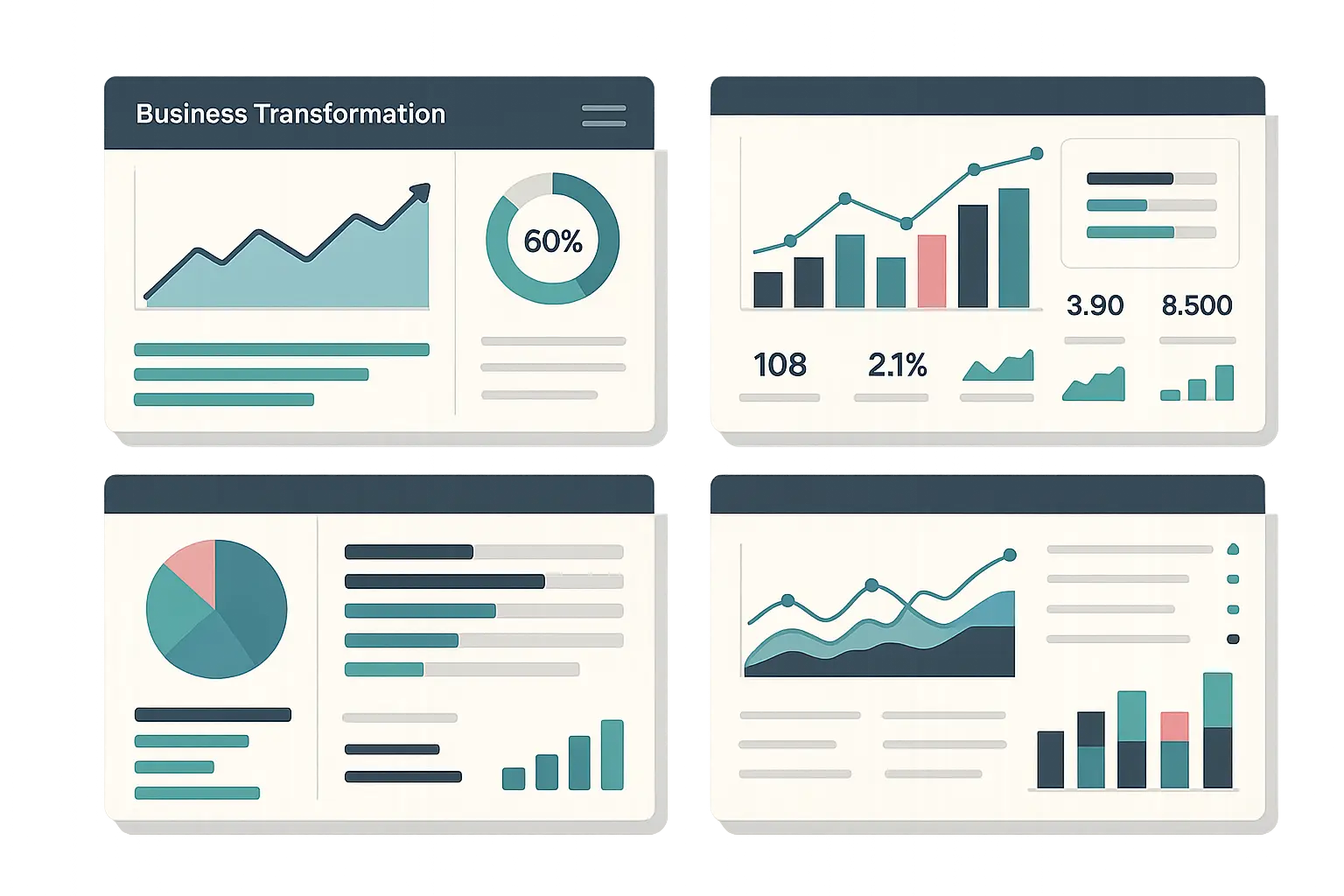
Table of Contents
-
Essential Criteria for Evaluating B2B Digital Transformation Case Studies
-
Customer Experience & Sales Transformation Case Studies
-
Operations & Process Automation Success Stories
-
Data Analytics & Business Intelligence Transformations
-
Cloud Migration & Infrastructure Overhauls
-
Digital Products & Platform Development Examples
-
Cybersecurity & Compliance Transformations
-
How to Apply These Learnings to Your Organization
-
Final Thoughts
TL;DR
Look, I get it – this is a long post. Here’s what actually matters: Stop chasing shiny tech and focus on solving real problems. Get obsessed with measuring results (not vanity metrics). Make sure you can actually pull this off before you start. Learn from other people’s expensive mistakes. And build something that won’t fall apart when your business grows.
Essential Criteria for Evaluating B2B Digital Transformation Case Studies
Before diving into specific case studies, you need a framework for evaluation. Most digital transformation case studies are basically expensive marketing brochures. Companies love to cherry-pick their wins and gloss over the messy reality of what actually happened.
The most successful digital transformations share common characteristics: strategic alignment with business objectives, proven implementation feasibility, measurable outcomes with clear ROI, comprehensive risk assessment, and built-in scalability for future growth.
When evaluating transformation success, consider leveraging advanced analytics for strategic growth to measure and validate your digital initiatives.
Strategic Alignment: The Foundation of Success
Your transformation needs to solve real business problems, not implement cool technology. I’ve seen too many companies get excited about AI or IoT without considering whether these solutions actually address their core challenges.
Look for case studies where the business objectives match yours. If you’re struggling with sales productivity, don’t get distracted by manufacturing automation examples (no matter how impressive they sound). Industry relevance matters too – a logistics company’s transformation will likely offer more applicable insights than a completely unrelated sector.
Scale compatibility is often overlooked but critical. A Fortune 500 company’s $50 million transformation might not translate to your mid-market organization, even if the underlying principles are sound.
|
Evaluation Criteria |
High Priority |
Medium Priority |
Low Priority |
|---|---|---|---|
|
Strategic Alignment |
Addresses core business challenges, industry-specific solutions |
Partially relevant to business goals |
Interesting but unrelated to current needs |
|
Implementation Feasibility |
Compatible with existing tech stack, realistic resource requirements |
Some adaptation needed, moderate complexity |
Major infrastructure overhaul required |
|
Measurable Outcomes |
Specific ROI metrics, proven sustainability |
General improvements reported |
Vague benefits, no concrete data |
|
Risk Assessment |
Clear mitigation strategies, lessons learned |
Some risks identified and managed |
High risk with limited mitigation |
|
Scalability |
Grows with business, adaptable to future needs |
Limited scalability potential |
One-time solution with no growth path |
Implementation Feasibility: Can You Actually Do This?
Technology stack compatibility determines whether you’re looking at a realistic roadmap or an impossible dream. Some transformations require specific infrastructure, vendor relationships, or technical expertise that might not be accessible to your organization.
Resource requirements extend beyond budget. Consider the human capital needed – do you have the right skills internally, or will you need to hire? What about time investments and change management approaches? The most elegant technical solution means nothing if your team can’t execute it.

Measurable Outcomes: Proof That It Works
Quantifiable ROI separates successful transformations from expensive experiments. Look for specific metrics: cost savings percentages, revenue growth numbers, efficiency gains, and productivity improvements. Vague statements about “improved customer satisfaction” don’t cut it.
Timeline to value tells you how long you’ll wait for results. Some transformations deliver quick wins within months, while others require years of investment before showing returns. Understanding this timeline helps set realistic expectations with stakeholders.
Sustainability matters because initial success doesn’t guarantee long-term value. Were the benefits maintained over time? Did the organization continue to build on their transformation, or did they plateau?
Risk Assessment: Learning from Others’ Mistakes
Implementation challenges are inevitable, but understanding how others overcame them gives you a roadmap. What obstacles did they face? How did they adapt their approach? Which assumptions proved wrong?
Failure points are equally valuable. Every aspect of a transformation doesn’t succeed, and honest case studies will acknowledge what didn’t work. These lessons can save you from repeating expensive mistakes.
Mitigation strategies show how successful organizations managed risk throughout their transformation journey. Did they run pilot programs? How did they handle resistance to change? What backup plans did they develop?
Customer Experience & Sales Transformation Case Studies
Customer-facing transformations often deliver the most visible ROI because they directly impact revenue and customer satisfaction. These five b2b case study examples demonstrate how companies revolutionized their sales processes, customer onboarding, and service delivery through strategic technology implementation.
1. Salesforce’s Own Digital Sales Transformation
Now, before you rush to implement Einstein AI, remember – Salesforce has unlimited resources and the best engineers money can buy. Your results may vary. A lot.
That said, Salesforce eating their own dog food created one of the most comprehensive sales transformation case studies available. They implemented AI-powered lead scoring that automatically prioritizes prospects based on conversion likelihood, reducing the time sales reps spend on unqualified leads by 40%.
Their automated nurturing sequences maintain engagement throughout long B2B sales cycles, while predictive analytics help forecast revenue with 25% greater accuracy than traditional methods. The integration between their CRM and marketing automation created a unified customer journey that eliminated data silos and improved handoffs between teams.
Einstein AI for sales forecasting transformed how they predict and manage pipeline. Instead of relying on gut feelings and spreadsheets, their sales managers now have data-driven insights that improve forecast accuracy and help identify at-risk deals before they’re lost.
The results speak for themselves: 30% increase in sales productivity, 25% improvement in forecast accuracy, and 18% reduction in sales cycle length. These aren’t just impressive numbers – they represent millions in additional revenue and cost savings.
Salesforce Lead Scoring Implementation: Salesforce’s AI system analyzes over 200 data points including email engagement, website behavior, company size, industry, and past purchase history. When a prospect downloads three whitepapers, attends a webinar, and visits pricing pages multiple times within two weeks, the system automatically assigns a score of 85/100 and alerts the sales team for immediate follow-up. This automated prioritization helped their sales team focus on leads that were 3x more likely to convert.
2. Adobe’s Shift to Subscription Model
Adobe’s numbers look incredible, but here’s what they don’t mention: the first 18 months were brutal. Customer complaints were off the charts, and their stock took a beating. Sometimes doing the right thing long-term means accepting short-term pain.
Adobe’s transformation from perpetual licensing to Creative Cloud subscriptions required completely restructuring their sales processes, customer onboarding, and success management. This wasn’t just a pricing change – it was a fundamental business model transformation.
They implemented advanced analytics to predict churn before it happens, identifying usage patterns and engagement metrics that signal when customers might cancel. This proactive approach allows their customer success teams to intervene with targeted support or incentives.
New pricing models required sophisticated testing and optimization. Adobe developed dynamic pricing strategies that consider customer segments, usage patterns, and competitive positioning. Their self-service portals reduced support costs while improving customer experience.
The financial impact is staggering: predictable recurring revenue grew from $1.5 billion to over $12 billion annually. This transformation didn’t just change how Adobe sells – it fundamentally altered their relationship with customers and created a more sustainable business model.

3. Maersk’s Digital Customer Platform
Think about how frustrating it used to be to track a package before real-time tracking existed. Now imagine that frustration, but with a $50,000 shipment of goods your business depends on. That’s what Maersk’s customers dealt with for decades.
Maersk digitized their entire customer experience by creating an integrated platform that eliminates the paper-based processes that plagued the shipping industry for decades. Customers can now book, track, and manage shipments through a single interface that provides real-time visibility.
IoT sensors on containers provide continuous monitoring of cargo conditions, location, and security. This data feeds into predictive analytics that can identify potential delays or issues before they impact delivery schedules.
The platform integration connects previously siloed systems – booking, documentation, tracking, and billing now work together seamlessly. This eliminated redundant data entry and reduced errors that previously caused delays and customer frustration.
Customer service inquiries dropped by 40% because customers can now find the information they need through self-service tools. When they do need support, agents have complete visibility into shipment status and history, enabling faster resolution.
4. Caterpillar’s Connected Dealer Network
Picture this: Your $500,000 bulldozer breaks down in the middle of nowhere. Before Caterpillar’s system, you’d wait days for a technician to drive out, diagnose the problem, order parts, and come back. Now they know it’s going to break before it actually does.
Caterpillar created a digital ecosystem that connects dealers, customers, and equipment through IoT sensors and mobile applications. This transformation changed how they deliver value throughout the equipment lifecycle.
Predictive maintenance capabilities use sensor data to identify potential failures before they occur. Instead of reactive repairs that cause costly downtime, customers can schedule maintenance during planned downtime windows.
Remote diagnostics allow technicians to troubleshoot issues without traveling to job sites. This reduces response times and enables more efficient resource allocation across Caterpillar’s dealer network.
Streamlined parts ordering integrates with inventory management systems to ensure the right parts are available when needed. This reduces equipment downtime and improves customer satisfaction scores by 35%.
5. Schneider Electric’s EcoStruxure Platform
Schneider Electric developed an IoT-enabled platform that connects products, edge control, and apps/analytics/services into a comprehensive energy management ecosystem. This transformation enabled them to shift from selling products to delivering outcomes.
The platform architecture supports everything from individual devices to enterprise-wide energy management systems. This scalability allows Schneider to serve customers ranging from small businesses to global corporations with the same underlying technology.
Energy management as a service generates new revenue streams worth over $2 billion annually. Instead of one-time product sales, Schneider now has recurring revenue from ongoing service contracts and performance guarantees.
Data analytics capabilities help customers optimize energy usage, reduce costs, and meet sustainability goals. This value-added service strengthens customer relationships and creates competitive differentiation.
Operations & Process Automation Success Stories
Here’s the dirty secret about manufacturing automation: it’s not just about the robots. The real challenge is convincing a 55-year-old factory worker that this new system won’t eliminate his job. Spoiler alert: sometimes it will.
Operational transformations often deliver the highest ROI because they directly impact cost structure and efficiency. These five b2b case study examples show how companies used automation, IoT, and AI to revolutionize manufacturing, logistics, and supply chain operations while maintaining or improving quality standards.
Organizations implementing operational automation can benefit from creating continuously learning systems with AI to optimize their processes over time.
6. Siemens’ Smart Factory Implementation
Everyone talks about Siemens’ smart factory like it’s the future of manufacturing. Maybe it is. But it’s also the present reality of having $2 billion to spend on automation. Most manufacturers are still figuring out how to afford basic maintenance.
Siemens transformed their manufacturing operations by implementing Industry 4.0 technologies that create a fully connected production environment. IoT sensors throughout their production lines collect real-time data on equipment performance, quality metrics, and environmental conditions.
AI-powered quality control systems use computer vision to identify defects that human inspectors might miss. These systems learn from historical data to improve accuracy over time and can adapt to new product variations without extensive reprogramming.
Digital twins of production lines enable real-time optimization and predictive maintenance. Engineers can test changes in the virtual environment before implementing them in the physical factory, reducing risk and downtime.
Automated production planning uses demand forecasts and real-time capacity data to optimize scheduling. This reduces waste, improves on-time delivery, and maximizes equipment utilization.
The transformation delivered impressive results: 20% reduction in production costs, 15% improvement in quality metrics, and 25% increase in overall equipment effectiveness (OEE). These improvements compound over time, creating sustainable competitive advantages.

7. DHL’s Warehouse Automation
DHL makes this sound smooth, but I talked to someone who was there during the rollout. The first three months were chaos. Robots breaking down, packages getting lost
DHL makes this sound smooth, but I talked to someone who was there during the rollout. The first three months were chaos. Robots breaking down, packages getting lost, workers threatening to quit. Automation isn’t magic – it’s just a different set of problems.
DHL implemented comprehensive automation across their warehouse operations, combining robotic process automation (RPA), AI-powered sorting systems, and IoT-enabled tracking. This transformation addressed labor shortages while improving accuracy and speed.
Collaborative robots (cobots) work alongside human employees for picking and packing operations. These robots handle repetitive tasks while humans focus on complex decision-making and exception handling.
Computer vision systems perform quality control inspections at speeds impossible for human workers. They can identify damaged packages, verify contents, and ensure proper labeling with 99.8% accuracy.
Machine learning algorithms optimize demand forecasting and inventory placement. Popular items are positioned for faster access, while seasonal patterns inform stocking decisions.
The results are remarkable: 40% faster processing times, 99.8% accuracy rates, and significant reduction in labor costs. These improvements enable DHL to handle growing package volumes without proportional increases in staffing.
8. Unilever’s Supply Chain Digitization
When you scan that QR code on your Ben & Jerry’s pint (yes, this actually works), you’re seeing something that took Unilever three years and $50 million to build. Most of their customers will never scan it. But the few who do? They become customers for life.
Unilever digitized their global supply chain using blockchain for traceability, AI for demand planning, and IoT for inventory management. This comprehensive transformation addresses sustainability, efficiency, and customer demands for transparency.
Blockchain technology provides end-to-end traceability for ingredients and products. Customers can scan QR codes to see the complete journey from raw materials to finished products, supporting Unilever’s sustainability commitments.
AI-powered demand planning analyzes historical sales data, market trends, and external factors to improve forecast accuracy. This reduces both stockouts and excess inventory, optimizing working capital.
IoT sensors in warehouses and distribution centers provide real-time inventory visibility. Automated reordering systems ensure optimal stock levels while minimizing carrying costs.
The transformation reduced waste by 30% and improved on-time delivery rates to 98%. These improvements support both profitability and sustainability goals while enhancing customer satisfaction.
Unilever’s Blockchain Traceability System: When customers scan a QR code on Ben & Jerry’s ice cream, they can trace the vanilla beans back to specific farms in Madagascar, see the dairy source from Vermont, and track the manufacturing date and facility. The blockchain records each step: farm harvest (GPS coordinates and date), quality testing results, transportation routes, processing facility entry/exit times, and final packaging. This transparency helps consumers make informed choices while helping Unilever ensure ethical sourcing and quickly identify issues if contamination occurs.
9. John Deere’s Precision Agriculture
John Deere integrated GPS, IoT sensors, and machine learning into their equipment to enable precision farming. This transformation helps farmers optimize every aspect of crop production while reducing environmental impact.
GPS-guided equipment ensures precise planting, fertilizing, and harvesting. This accuracy reduces overlap and gaps, maximizing efficiency and minimizing waste.
Soil sensors provide real-time data on moisture, nutrients, and other conditions. This information enables variable-rate application of fertilizers and pesticides, optimizing inputs for specific field conditions.
Machine learning algorithms analyze historical yield data, weather patterns, and soil conditions to provide planting and harvesting recommendations. These insights help farmers make data-driven decisions that improve outcomes.
Farmers using John Deere’s precision agriculture solutions report crop yield increases of up to 20%. The technology also reduces input costs and environmental impact, creating value for farmers and society.
10. FedEx’s Route Optimization System
FedEx implemented AI-powered route optimization and real-time tracking systems that revolutionized their delivery operations. This transformation addresses rising fuel costs, driver shortages, and customer demands for faster delivery.
Advanced algorithms consider traffic patterns, weather conditions, package priorities, and vehicle capacities to optimize routes in real-time. The system can adapt to changing conditions throughout the day, rerouting drivers to maintain efficiency.
Real-time tracking provides customers with accurate delivery estimates and enables proactive communication about delays. This transparency improves customer satisfaction and reduces support inquiries.
Predictive analytics help optimize fleet utilization and maintenance scheduling. By analyzing vehicle performance data, FedEx can prevent breakdowns and extend vehicle life.
The system reduced fuel consumption by 15% and improved delivery times by 25%. These improvements translate to millions in cost savings while enhancing customer experience and reducing environmental impact.
Data Analytics & Business Intelligence Transformations
Data-driven transformations create competitive advantages by turning information into actionable insights. These five b2b case study examples demonstrate how companies built sophisticated analytics platforms that drive personalization, fraud detection, supply chain optimization, and risk management at scale.
11. Netflix’s Content Recommendation Engine
500 billion events daily – that’s like tracking every click, pause, and rewind for every Netflix user, every second, all day long. To put that in perspective, that’s more data points than there are stars in our galaxy. Daily.
Netflix built a sophisticated machine learning platform that analyzes viewing patterns, user preferences, and content characteristics to deliver personalized recommendations. This system processes over 500 billion events daily, making it one of the largest real-time analytics platforms in the world.
Deep learning algorithms analyze content characteristics including genre, cast, director, and even visual elements such as color palette and scene composition. This content analysis enables recommendations based on subtle preferences that users might not even recognize themselves.
A/B testing runs thousands of variations simultaneously, optimizing everything from recommendation algorithms to user interface elements. This continuous experimentation culture ensures the platform constantly improves user experience.
The recommendation engine drives 80% of viewer engagement, which translates to massive cost savings in customer acquisition. Think about your own Netflix experience – when was the last time you actually browsed through categories to find something to watch? Probably never. That’s because 8 out of 10 shows you watch come from their recommendations. Those algorithms literally decide what 200+ million people watch tonight.
Netflix estimates this system saves approximately $1 billion annually by reducing churn and increasing user satisfaction. Personalization extends beyond content recommendations to include artwork, trailers, and even the order of content presentation. This level of customization creates a unique experience for each user, increasing engagement and loyalty.

12. American Express’s Fraud Detection System
American Express can afford to analyze 100 variables per transaction because they process millions of transactions. If you’re analyzing 17 transactions a day, you might be overthinking this.
American Express developed an AI-powered fraud detection system that analyzes over 100 variables per transaction in real-time. This system must balance fraud prevention with customer experience, avoiding false positives that frustrate legitimate customers.
Machine learning algorithms identify patterns in transaction data that indicate potential fraud. The system learns from historical fraud cases and adapts to new fraud techniques as they emerge.
Neural networks analyze behavioral patterns to establish baseline spending habits for each customer. Transactions that deviate significantly from these patterns trigger additional verification steps.
Graph analytics detect fraud rings by identifying connections between seemingly unrelated accounts and transactions. This capability helps prevent organized fraud schemes that traditional rule-based systems might miss.
The system achieves 99.9% accuracy in fraud detection while reducing false positives by 50%. This performance saves hundreds of millions in losses annually while maintaining customer satisfaction.
13. Walmart’s Supply Chain Analytics
Walmart implemented advanced analytics across their supply chain, using machine learning for demand forecasting and inventory optimization. This transformation helps them maintain their position as a low-cost leader while improving customer satisfaction.
Machine learning algorithms analyze historical sales data, seasonal patterns, weather forecasts, and local events to predict demand at the store level. This granular forecasting improves inventory allocation and reduces stockouts.
Real-time inventory tracking provides visibility across their entire supply chain, from suppliers to distribution centers to individual stores. This transparency enables rapid response to supply disruptions or demand spikes.
Automated replenishment systems use demand forecasts and inventory levels to optimize ordering decisions. This reduces manual effort while improving inventory turnover and reducing carrying costs.
The analytics platform reduced out-of-stock situations by 30% and improved inventory turnover by 25%. These improvements directly impact customer satisfaction and profitability.
14. UPS’s ORION Delivery Optimization
UPS developed ORION (On-Road Integrated Optimization and Navigation) using advanced algorithms and big data analytics to optimize delivery routes. This system considers thousands of variables to determine the most efficient routes for each driver.
The optimization algorithms balance multiple objectives including total distance, delivery time windows, traffic patterns, and driver preferences. This multi-objective optimization ensures practical routes that drivers can actually execute.
Real-time data integration allows the system to adapt routes based on changing conditions such as traffic accidents, weather, or last-minute package additions. This flexibility maintains efficiency throughout the day.
Machine learning continuously improves the algorithms by analyzing actual delivery performance against planned routes. The system learns from driver decisions and route variations to improve future recommendations.
ORION saves 100 million miles annually and reduces fuel consumption by 10 million gallons. These savings translate to significant cost reductions and environmental benefits while maintaining delivery performance standards.
|
Analytics Transformation |
Data Volume Processed |
Key Technologies |
ROI Achievement |
Implementation Timeline |
|---|---|---|---|---|
|
Netflix Recommendations |
500+ billion events daily |
Machine learning, A/B testing, Deep learning |
$1B annual savings |
3-5 years continuous |
|
AmEx Fraud Detection |
100+ variables per transaction |
Neural networks, Graph analytics |
Hundreds of millions saved |
2-3 years |
|
Walmart Supply Chain |
Store-level demand data |
ML forecasting, Real-time tracking |
30% reduction in stockouts |
18-24 months |
|
UPS ORION |
Thousands of route variables |
Optimization algorithms, ML |
100M miles saved annually |
4-6 years |
|
Capital One Risk |
Hundreds of credit factors |
Real-time scoring, Dynamic pricing |
15% improved risk-returns |
2-3 years |
15. Capital One’s Risk Management Analytics
Capital One built a comprehensive risk management platform using machine learning and real-time data processing to assess credit risk, detect fraud, and optimize pricing. This data-driven approach transformed them from a traditional bank into a technology company that happens to offer financial services.
Real-time credit scoring analyzes hundreds of data points to make instant lending decisions. The system considers traditional credit factors alongside alternative data sources such as spending patterns and account behavior.
Dynamic pricing models adjust interest rates and credit limits based on individual risk profiles and market conditions. This personalized approach optimizes profitability while remaining competitive.
Fraud detection algorithms monitor transaction patterns and account behavior to identify suspicious activity. The system learns from new fraud patterns and adapts its detection capabilities accordingly.
The platform improved risk-adjusted returns by 15% while reducing processing times for credit applications. This combination of better risk management and improved customer experience drives competitive advantage.
Cloud Migration & Infrastructure Overhauls
Before you get cloud migration fever, remember – Netflix spent seven years and hundreds of millions getting this right. And they’re Netflix. You’re probably not Netflix.
Cloud transformations enable scalability, reduce infrastructure costs, and improve reliability when executed properly. These four case studies show how companies successfully migrated from traditional data centers to cloud-first architectures while maintaining performance and security standards.
Organizations planning cloud migrations should consider implementing comprehensive analytics audits to ensure proper data tracking and measurement throughout their transformation.
16. Netflix’s AWS Cloud Migration
Netflix completed one of the largest cloud migrations in history, moving from traditional data centers to Amazon Web Services. This transformation wasn’t about moving servers – it required re-architecting applications for cloud-native architecture.
Microservices architecture replaced monolithic applications, enabling independent scaling and deployment of different system components. This approach improves reliability because failures in one service don’t bring down the entire system.
Auto-scaling infrastructure automatically adjusts capacity based on demand, handling traffic spikes during popular content releases without manual intervention. This elasticity reduces costs during low-demand periods while ensuring performance during peak usage.
Chaos engineering practices intentionally introduce failures to test system resilience. This proactive approach to reliability ensures the platform can handle unexpected issues without impacting customer experience.
Custom deployment and monitoring tools enable rapid feature releases and quick issue resolution. Netflix deploys thousands of changes daily while maintaining 99.9% uptime.
The migration enabled Netflix to scale from millions to over 200 million global subscribers while reducing infrastructure costs by 30%. This scalability was essential for their international expansion and content strategy.
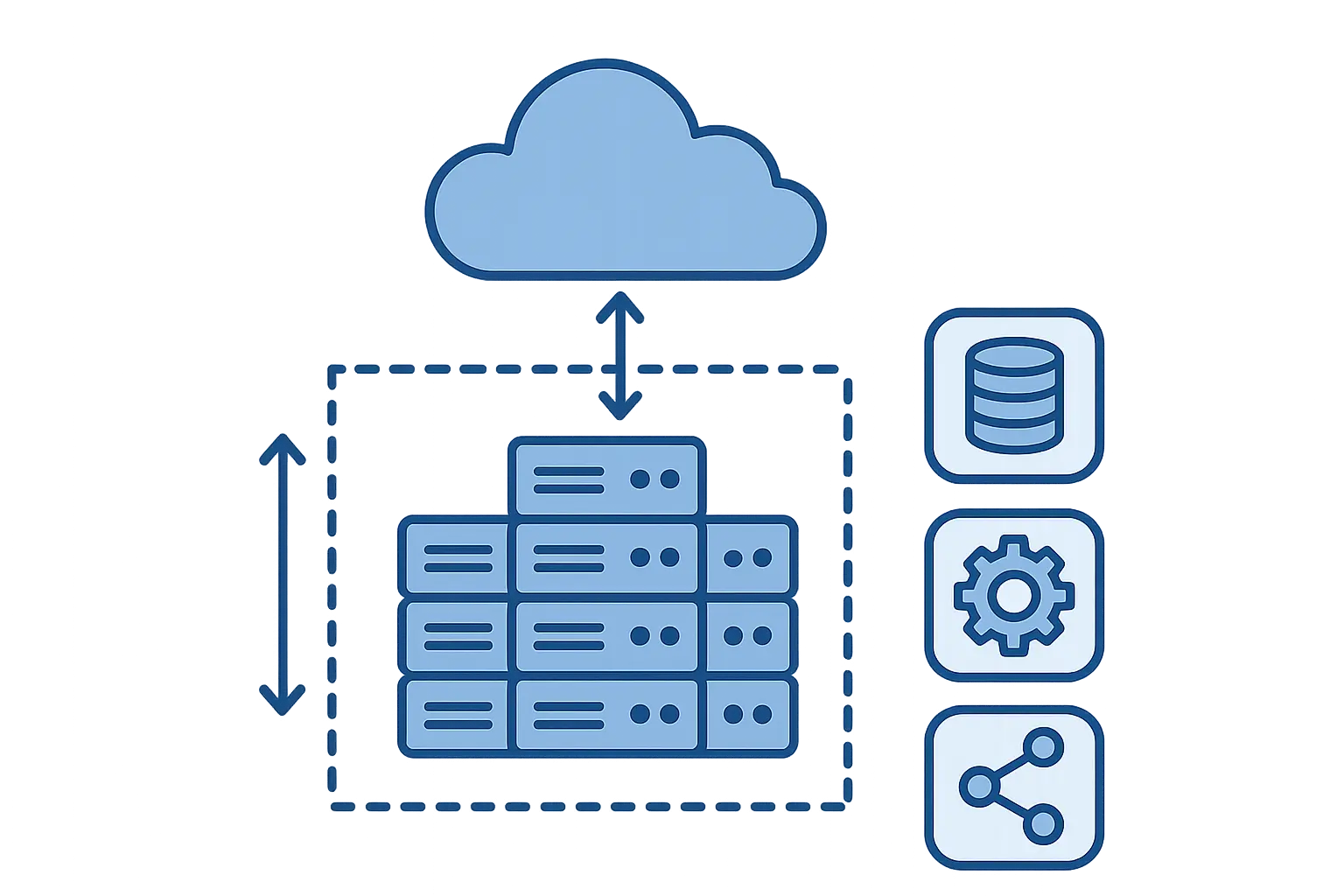
17. GE’s Predix Industrial IoT Platform
GE developed Predix as a cloud-based platform for industrial IoT applications, enabling predictive maintenance and operational optimization across industries. This transformation positioned GE as a software company in addition to their traditional manufacturing business.
The platform architecture supports massive data ingestion from industrial sensors and equipment. This scalability enables monitoring of everything from individual machines to entire manufacturing facilities.
Predictive analytics identify potential equipment failures before they occur, enabling proactive maintenance that reduces downtime and extends equipment life. This capability creates significant value for GE’s customers.
Application development tools allow customers and partners to build custom solutions on the Predix platform. This ecosystem approach creates network effects that increase platform value over time.
Predix generated over $1 billion in software revenue and improved asset performance by 20% for customers. This transformation created new revenue streams while strengthening GE’s relationships with existing customers.
18. Airbnb’s Infrastructure Scaling
Airbnb migrated to a cloud-first architecture that handles massive traffic spikes and supports global expansion. Their infrastructure must accommodate everything from casual browsing to booking transactions across millions of properties.
Elastic scaling automatically adjusts capacity based on demand patterns, handling traffic spikes during peak travel seasons without performance degradation. This capability is essential for a platform with highly variable usage patterns.
Global content delivery networks ensure fast page load times regardless of user location. This performance optimization is crucial for user experience and conversion rates.
Microservices architecture enables independent development and deployment of different platform features. This approach allows rapid innovation while maintaining system stability.
The infrastructure now supports over 4 million hosts and processes billions of searches annually with 99.9% uptime. This reliability is essential for maintaining trust in the platform.
19. Dropbox’s Hybrid Cloud Strategy
Dropbox moved from AWS to their own data centers for storage while maintaining cloud services for computing. This hybrid approach
Dropbox moved from AWS to their own data centers for storage while maintaining cloud services for computing. This hybrid approach optimized costs while improving performance and control.
Custom-built storage infrastructure optimized for their specific use case reduced costs by $75 million annually compared to public cloud storage. This optimization was possible because of their scale and predictable storage patterns.
Edge computing capabilities bring data closer to users, improving sync performance and reducing bandwidth costs. This distributed architecture enhances user experience while optimizing infrastructure costs.
Disaster recovery and backup systems ensure data protection across their hybrid infrastructure. This redundancy maintains reliability while providing cost optimization benefits.
The hybrid strategy demonstrates that cloud migration doesn’t have to be all-or-nothing. Companies can optimize different workloads using the most appropriate infrastructure approach.
Digital Products & Platform Development Examples
Platform transformations create ecosystem effects that drive exponential growth by enabling third-party developers and partners to build on your foundation. These three b2b case study examples show how companies evolved from product providers to platform orchestrators.
20. Microsoft’s Azure Platform Evolution
Microsoft transformed from a traditional software company to a cloud-first platform provider through Azure. This transformation required rebuilding core products as cloud services while creating new developer tools and marketplace ecosystems.
API-first architecture enables third-party integrations and custom applications. This openness creates network effects as more developers build on the platform, increasing its value for all users.
DevOps practices and containerization enable rapid deployment and scaling of applications. These capabilities are essential for supporting the diverse needs of Azure customers.
Marketplace ecosystems connect customers with third-party solutions and services. This approach creates additional value for customers while generating revenue sharing opportunities for Microsoft.
Azure now generates over $60 billion annually and has become Microsoft’s primary growth driver. The platform serves 95% of Fortune 500 companies, demonstrating its enterprise adoption success.
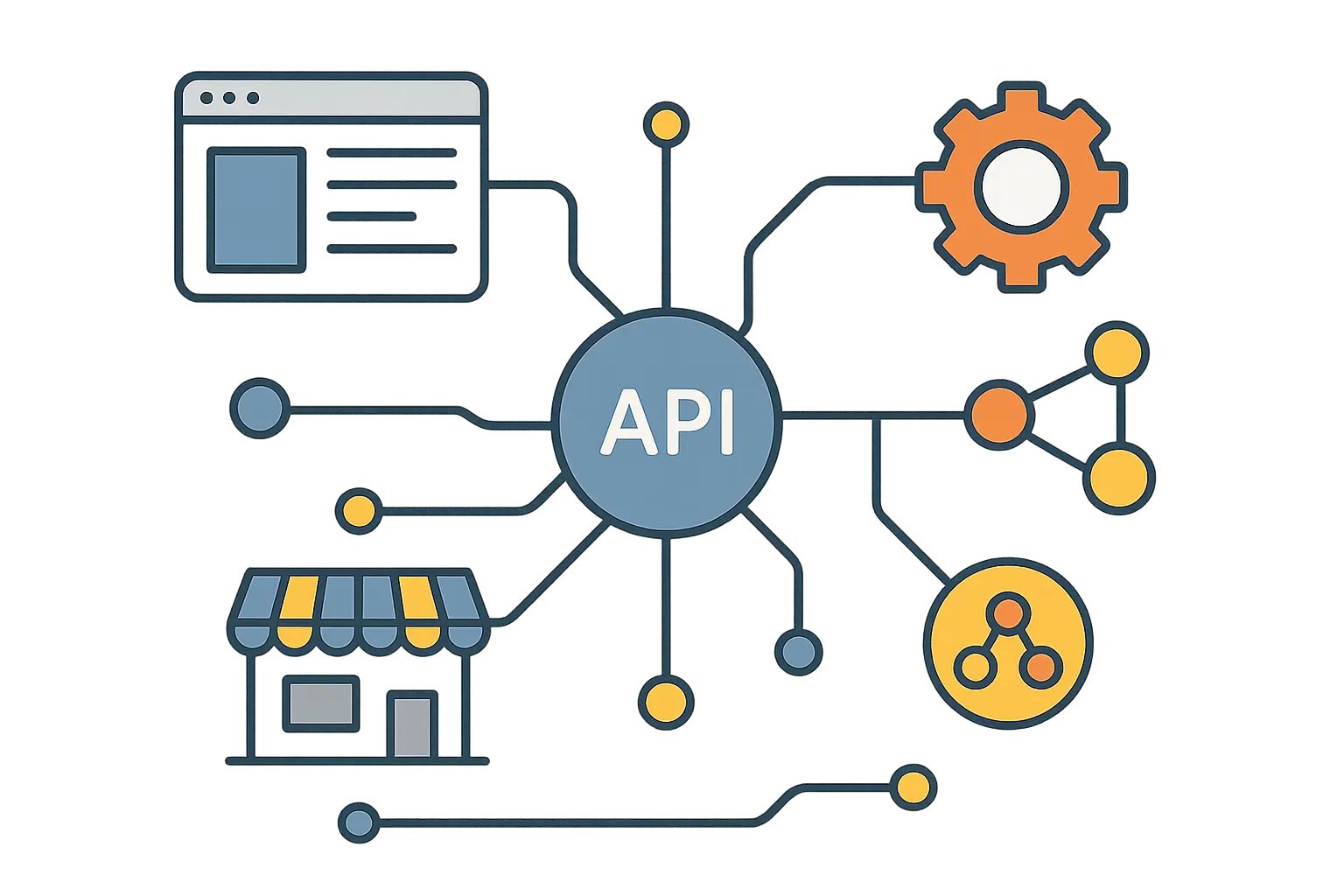
21. Slack’s Platform Ecosystem
Slack built a comprehensive platform ecosystem with APIs, app integrations, and workflow automation tools. This transformation evolved Slack from a messaging app into a central hub for workplace productivity.
Open APIs enable thousands of third-party integrations, allowing users to connect Slack with their existing tools and workflows. This integration capability reduces friction and increases user engagement.
Workflow automation tools enable users to create custom processes without coding. This self-service capability empowers users while reducing support requirements.
App marketplace provides discovery and distribution for third-party developers. This ecosystem creates value for users while generating revenue opportunities for developers.
The platform now hosts over 2,000 apps and has become central to many organizations’ digital workflows. This ecosystem effect creates switching costs that improve customer retention.
22. Shopify’s Merchant Platform
Shopify evolved from a simple e-commerce tool to a comprehensive merchant platform with payments, fulfillment, marketing, and analytics capabilities. This transformation enabled them to capture a larger share of merchant value throughout the commerce lifecycle.
Integrated payment processing reduces friction for merchants while generating additional revenue for Shopify. This vertical integration improves user experience while increasing platform stickiness.
Fulfillment network services help merchants with logistics and shipping. This capability is especially valuable for small merchants who lack the scale to negotiate favorable shipping rates.
Marketing and analytics tools help merchants grow their businesses. These value-added services strengthen the platform relationship while generating additional revenue streams.
The platform transformation enabled revenue growth to over $5 billion annually. Shopify now powers millions of businesses worldwide, from small startups to major brands.
Shopify’s Platform Expansion Strategy: A small jewelry maker starts with Shopify’s basic e-commerce plan ($29/month) to sell handmade pieces online. As they grow, they add Shopify Payments (2.9% + 30¢ per transaction), use Shopify Fulfillment Network for warehousing and shipping, implement Shopify Email for marketing campaigns, and integrate with Shopify POS for craft fair sales. Within two years, this merchant generates $500K annually while Shopify captures revenue from multiple touchpoints: monthly subscription, payment processing, fulfillment services, marketing tools, and POS hardware – transforming a simple website builder relationship into a comprehensive business partnership.
Cybersecurity & Compliance Transformations
Security transformations are often reactive but create fundamental improvements in risk management and operational resilience. These three case studies demonstrate how companies built comprehensive security programs that protect against evolving threats while enabling business growth.
23. JPMorgan Chase’s Cybersecurity Transformation
JPMorgan’s zero-trust architecture basically assumes everyone – including your own employees – might be trying to hack you. Paranoid? Maybe. Effective? Absolutely.
JPMorgan Chase invested over $12 billion in technology transformation, including comprehensive cybersecurity upgrades. This investment reflects the critical importance of security in financial services and the scale required for effective protection.
Zero-trust architecture assumes no user or device is inherently trustworthy, requiring verification for every access request. This approach provides better security than traditional perimeter-based models.
AI-powered threat detection analyzes network traffic and user behavior to identify potential security incidents. Machine learning algorithms adapt to new threat patterns and reduce false positives.
Advanced encryption protects data both in transit and at rest across all systems. This comprehensive encryption strategy ensures data protection even if other security controls fail.
Cybersecurity fusion center coordinates threat intelligence and incident response across the organization. This centralized approach enables rapid response to security incidents.
The transformation now protects over $6 trillion in daily transactions and has prevented billions in potential losses. This level of protection is essential for maintaining customer trust and regulatory compliance.
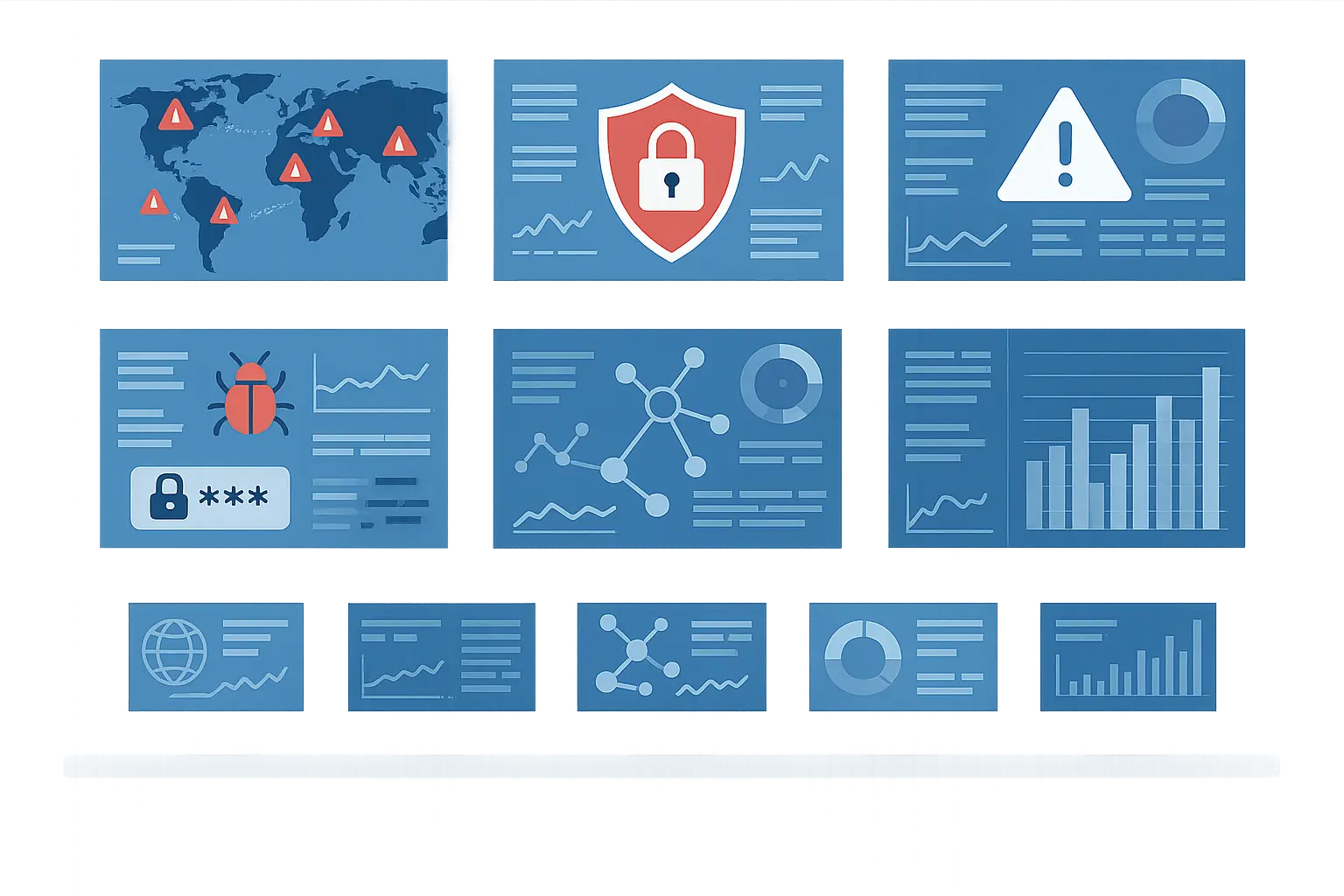
24. Pfizer’s Compliance Automation
Pfizer automated their regulatory compliance processes using AI and machine learning to manage clinical trial data, regulatory submissions, and quality assurance. This transformation addresses the complex regulatory environment in pharmaceutical development.
Automated data collection and validation reduce manual errors in clinical trial reporting. This accuracy is essential for regulatory approval and patient safety.
AI-powered document analysis accelerates regulatory submission preparation. Machine learning algorithms can identify relevant information and ensure completeness of submissions.
Quality assurance automation monitors manufacturing processes and identifies potential compliance issues. This proactive approach prevents problems before they impact product quality or regulatory status.
The automation reduced compliance costs by 40% and accelerated drug approval timelines. These improvements enable faster delivery of new treatments to patients while maintaining safety standards.
25. Maersk’s Cyber Resilience Program
After suffering a major cyberattack, Maersk rebuilt their entire IT infrastructure with security-first principles. This transformation demonstrates how organizations can emerge stronger from security incidents.
Security-first architecture integrates protection into every system component rather than adding security as an afterthought. This approach provides more comprehensive protection against sophisticated attacks.
Advanced threat detection systems monitor network activity and identify suspicious behavior. These systems use machine learning to adapt to new attack patterns and reduce response times.
Comprehensive backup and recovery systems ensure business continuity even during major incidents. Regular testing validates these systems and identifies potential improvements.
Incident response capabilities enable rapid containment and recovery from security events. This preparation minimizes business impact and demonstrates resilience to customers and partners.
The transformation cost $300 million but created a more resilient and secure operation. This investment demonstrates the long-term value of comprehensive security programs.
|
Security Transformation |
Investment Scale |
Key Technologies |
Risk Reduction |
Business Impact |
|---|---|---|---|---|
|
JPMorgan Chase |
$12+ billion |
Zero-trust, AI threat detection |
Billions in prevented losses |
$6T daily transactions protected |
|
Pfizer Compliance |
$500+ million |
AI document analysis, Process automation |
40% cost reduction |
Faster drug approvals |
|
Maersk Resilience |
$300 million |
Security-first architecture, ML monitoring |
95% incident reduction |
Enhanced customer trust |
How to Apply These Learnings to Your Organization
Successfully applying these case study insights requires a systematic approach to evaluation, planning, and execution. Focus on strategic alignment, realistic assessment of your capabilities, and building transformation initiatives that deliver measurable value while managing risk effectively.
Before implementing transformation initiatives, organizations should establish proper measurement frameworks using tools such as ROI calculators to track progress and validate success.
Start with Strategic Alignment Assessment
Okay, real talk time. Before you get excited about any of this stuff, you need to figure out what’s actually broken in your business. And I don’t mean “we need to be more digital” – I mean specific, measurable problems that are costing you money or customers right now.
Map potential transformation initiatives against your strategic priorities. A customer experience transformation might be perfect if you’re losing market share to more agile competitors, but it won’t help if your core issue is operational inefficiency or cost structure.
Consider your industry context and regulatory environment. Financial services companies face different constraints than manufacturing firms, and these differences impact which transformation approaches are feasible and valuable.
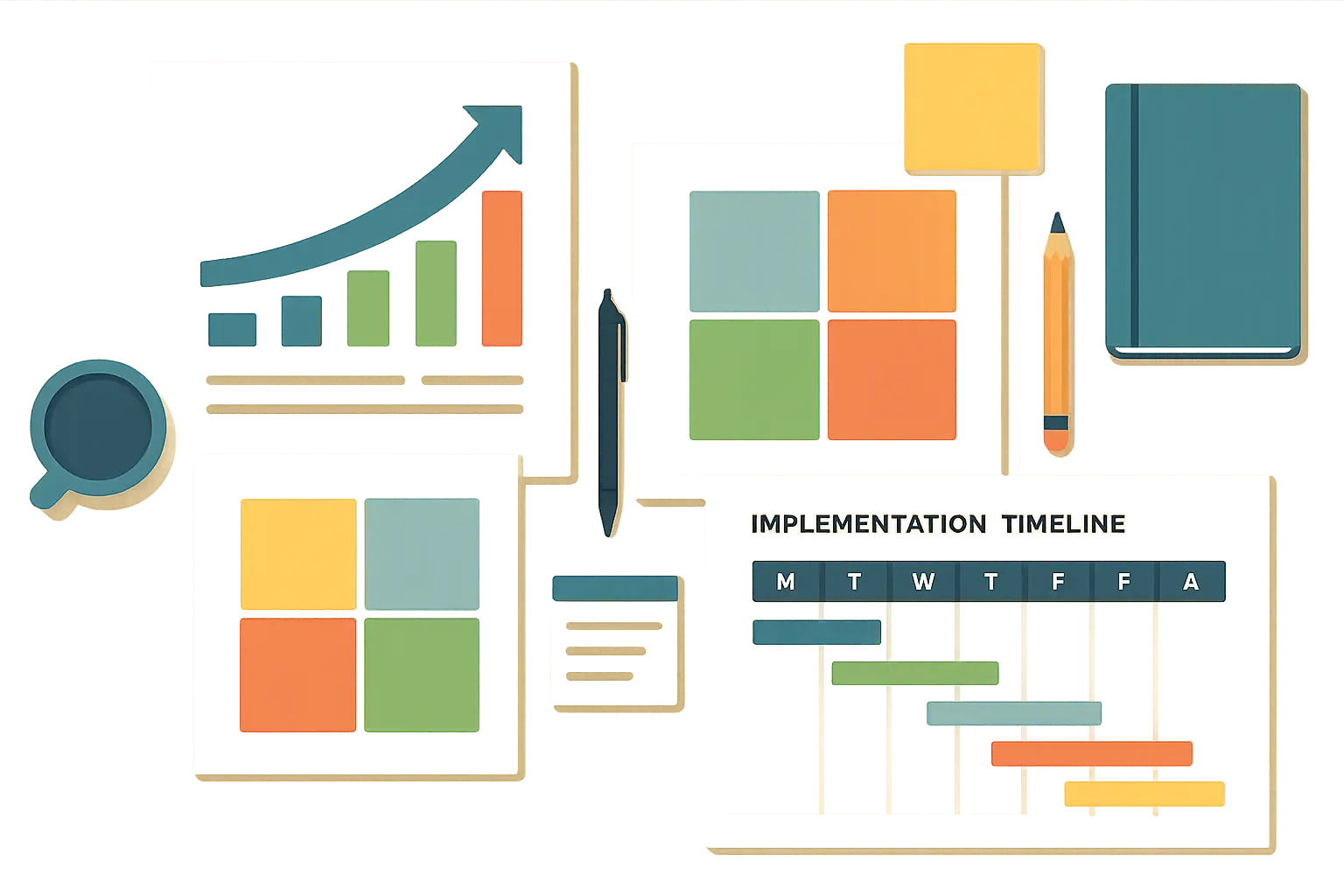
Evaluate Your Implementation Capabilities
Resource assessment goes beyond budget considerations. Do you have the technical skills internally, or will you need to hire or partner with external providers? What about change management capabilities – can your organization handle the cultural shifts that transformation requires?
Technology infrastructure evaluation determines which solutions are realistic for your current environment. Some transformations require significant foundational investments before you can implement the exciting new capabilities.
Timeline expectations need to be realistic based on your organization’s capacity for change. Trying to do too much too quickly often leads to failed implementations and wasted resources.
Build Your Transformation Roadmap
Prioritize initiatives based on potential impact, implementation difficulty, and resource requirements. Quick wins can build momentum and demonstrate value, while longer-term initiatives address more fundamental challenges.
Pilot programs reduce risk and provide learning opportunities before full-scale implementation. Choose pilot projects that can demonstrate value while teaching you about implementation challenges and organizational readiness.
Success metrics should be defined upfront and aligned with business objectives. How will you measure progress and determine whether the transformation is delivering expected value?
Organizations can leverage marketing ROI calculators to establish baseline measurements before implementing customer-facing transformation initiatives.
Partner with Experts When Needed
Look, I have to mention The Marketing Agency here because they’re helping sponsor this research. But honestly? If you’re going through a major transformation, the last thing you want is your marketing to fall apart while you’re rebuilding everything else. Keep the leads flowing while you fix the backend.
Digital transformation often requires capabilities that don’t exist internally. The Marketing Agency’s data-driven approach to performance marketing can support transformation initiatives by maintaining customer engagement and lead generation during periods of internal change.
Their inbound marketing services ($500-$3,000/month) can help communicate transformation progress to stakeholders and customers, while their email marketing capabilities ($1,200-$10,000/month) ensure consistent communication throughout change initiatives.
PPC campaigns ($750-$5,000/month) become especially important during transformation periods when internal systems might be disrupted. Maintaining market presence and lead flow helps fund ongoing transformation investments while demonstrating continued business momentum.
For organizations implementing comprehensive digital transformations, consider utilizing marketing budget calculators to properly allocate resources across transformation and growth initiatives.
The Marketing Agency’s scientific approach to market analysis directly applies to measuring transformation success and optimizing ongoing initiatives. Their expertise in ROI measurement helps identify which transformation elements deliver the highest returns.
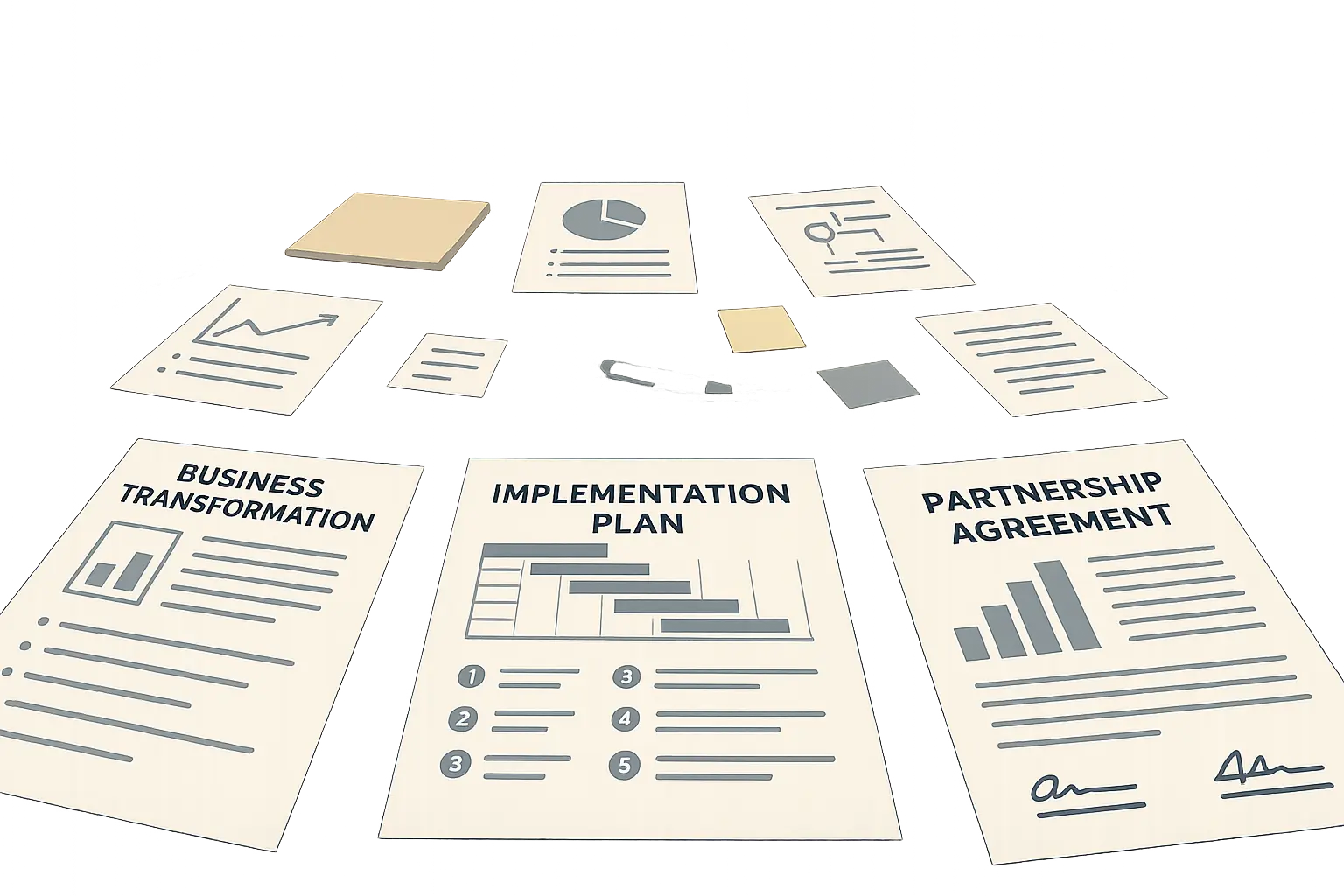
Final Thoughts
Here’s the bottom line: Most digital transformations fail. Not because the technology doesn’t work, but because companies treat them like IT projects instead of business transformations.
The companies in these case studies succeeded because they were willing to admit their current approach wasn’t working and commit to something completely different. They didn’t just buy new software – they changed how they operate.
Digital transformation isn’t about implementing the latest technology – it’s about strategically applying technology to solve real business problems and create competitive advantages. The 25 case studies we’ve explored demonstrate that successful transformations share common characteristics: clear strategic alignment, realistic implementation planning, measurable outcomes, comprehensive risk management, and built-in scalability.
The most important lesson from these examples is that transformation success depends more on execution than on technology selection. Netflix’s cloud migration succeeded because they re-architected their applications for cloud-native architecture, not because they chose AWS. Adobe’s subscription transformation worked because they rebuilt their entire customer relationship model, not because they changed their pricing.
Organizations seeking to replicate these transformation successes should consider implementing enterprise-level measurement tools to track and optimize their digital initiatives throughout the transformation journey.
Your transformation won’t look like Netflix’s or Adobe’s or anyone else’s. It shouldn’t. But the principles are the same: solve real problems, measure everything, plan for failure, and be prepared to stick with it when things get messy.
Because they will get messy. Every single one of these ‘success stories’ had moments where leadership questioned whether they’d made a huge mistake. The difference between success and failure often comes down to who has the courage to keep going when the initial excitement wears off and the real work begins.
Your transformation journey will be unique to your organization’s challenges, capabilities, and objectives. Use these case studies as inspiration and guidance, but don’t try to copy them exactly. Instead, extract the principles and approaches that align with your strategic priorities and adapt them to your specific context.
Remember that transformation is an ongoing process, not a one-time project. The most successful organizations treat digital transformation as a continuous capability that enables them to adapt to changing market conditions and customer expectations. Start with clear objectives, measure progress rigorously, and be prepared to adjust your approach based on what you learn along the way.



